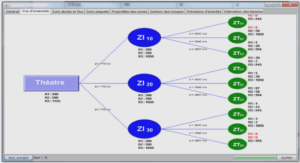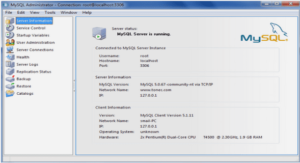Cours informatique life beyond Pascal – MODULA-2 from a users point of view, tutoriel & guide de travaux pratiques en pdf.
Neural Networks
Historical In pioneering work at Brunel University Professor Igor Aleksander developed the concept of the Unprogrammed Neural Network. This is a semi-distributed architecture based upon a RAM / Neuron analogy and which enabled the construction of cheap Neural Network Image Processing systems with a form of content addressability. A simple Neural Net is a group of RAM / Neurons mapped over a target image and the network classifies its input by summing the number of RAM / Neurons that fire on presentation of an arbitrary image.
Simple Neural Networks
A single RAM can be shown to classify simple binary images by mapping the image onto its address lines and storing a TRUE value at the image generated address, however more complex images force the use of ‘Compound RAMs’ [4], since RAM size increases exponentially with image size. A compound RAM uses multiple small RAMs to cover its image space. The number of address lines from each RAM mapped onto the image is defined as the n-tuple size of the system. The Network can be trained to recognise a specific pattern by storing TRUE at the address generated at each RAM by the target image. The systems response to an arbitrary image is defined as the number of RAM / Neurons that fire (output TRUE) on the presentation of the image. An Image Discriminator is one large compound RAM covering the target image, and a Neural Network system capable of classifying [n] distinct images is a set of [n] such Discriminators acting in parallel over the target image.
Edge Filtering by Retinal Ganglion Cells
In broad outline, the visual pathway from light passing through the eye lens to electrochemical ‘perception’ in the brain is well defined; light entering the eye is focussed onto Receptor cells on the retina. Output from these cells is collated by Bipolar cells which in turn connect to Retinal Ganglion cells, whose output passes to the Optic Nerve. This nerve carries signals from the eye until reaching a junction with the Optic Nerve from the other eye, called the chiasm. Here, about half of the fibres from each nerve cross into opposite hemispheres of the brain and lead to two cell clusters called the Lateral Geniculate Bodies from where signals pass on to the visual area of the Cerebral Cortex.
Contrast Processing occurs as information filters across Retinal Ganglion (RG) cells, of which Kuffler found two types in his investigation of the visual pathway, On-Centre and Off-Centre field cells. An On-Centre field cell receives excitatory input from a circular area at the centre of its receptive field and inhibitory input from the circular area surrounding the On-Centre (vice-versa for an Off-Centre field cell). The mechanism by which edge filtering takes place is that a spot of light covering the centre of the cell produces maximal cell firing, whereas any light falling on the surrounding Off field inhibits this firing, such that if light covers the entire receptive field, the cell fires weakly if at all. If however light falls only on the On-Centre the cell fires strongly, peaking when
the entire On Centre is covered.
Considering the behaviour of a network of such On-Centre field cells mapped over an image of a light square on a dark background, we see little activity on any of the cells whose receptive fields cover the dark background. There will also be little activity from the cells covering the light square, as the excitatory and inhibitory inputs tend to cancel out. However, at the boundary of light and dark there will be some activity as some cells will be more strongly excited by light on their On-Centre than inhibited by light falling on their Off surround. The net response of the system will thus be areas of high cell activity at the boundary of the light square and dark background – the edges of the square.




